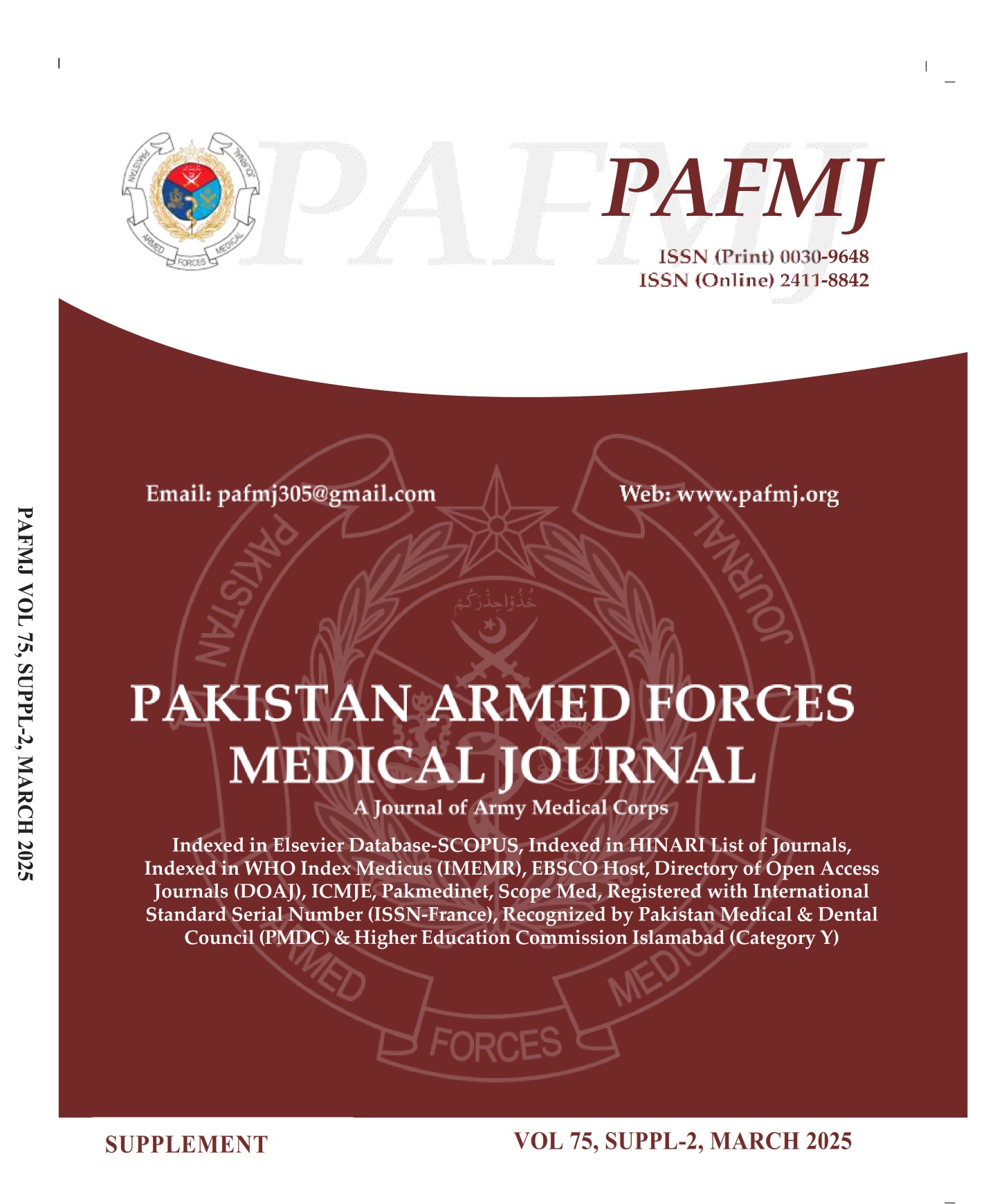Positive Predictive Rate of Breast Imaging-Reporting and Data System (BI-RADS) Category 4 Lesions For Breast Cancer Taking Histopathology as Gold Standard
DOI:
https://doi.org/10.51253/pafmj.v75iSUPPL-2.5857Keywords:
Breast Cancer, Breast Imaging-Reporting and Data System (Bi-Rads), Diagnostic Accuracy, MammographyAbstract
Objective: To determine positive predictive rate of Breast imaging-reporting and data system (BI-RADS) category 4 and its sub-categories for breast cancer taking histopathology as gold standard.
Study Design: Cross sectional validation study.
Place and Duration of Study: Department of Radiology, Pakistan Institute of Medical Sciences, Islamabad Pakistan, from Sep to Nov 2020.
Methodology: 60 female patients who were diagnosed as Breast imaging-reporting and data system (BI-RADS) category 4 lesions on mammography were included in the study and afterwards followed for biopsy report. Data was collected and analyzed using SPSSv25.
Results: Patient’s mean age was 50.6±9.7yrs. Among sixty patients with BIRADS 4, 13(21.7%) had BIRADS 4A, 22(36.7%) had BIRADS 4B and 25(41.7%) had 4C. Positive predictive value for BIRADS 4 was 68.33%, 4A was 15.3%, 4B was 72.7% and for 4C was 92%. Sensitivity & Specificity of BIRADS 4A being benign and BIRADS 4B, & 4C being malignant is 91.49% and 69.23% respectively. Overall, diagnostic accuracy of BIRADS 4B & 4C classification was found to be 83.33%.
Conclusion: Sub-categorization of Breast imaging-reporting and data system (BI-RADS) category 4 is not routinely practiced, however results of current study conclude that it helps to stratify the associated risk of malignancy and update the level of concern to referring physician and pathologist.
Downloads
References
Hunter CP. Epidemiology, stage at diagnosis, and tumor biology of breast carcinoma in multiracial and multiethnic populations. Cancer 2000; 88(S5): 1193-1202.
Ferlay JF. GLOBOCAN 2000. Cancer incidence, mortality and prevalence worldwide, Version 1.0. Available at:
http://ci.nii.ac.jp/naid/10015768449/en/
Sohail S, Shams N.Breast cancer in Pakistan - Awareness and early detection. J Coll Physicians Surg Pak 2007; 17 (12): 711-712.
Gulzar F, Akhtar MS, Sadiq R, Bashir S, Jamil S, Baig SM. Identifying the reasons for delayed presentation of Pakistani breast cancer patients at a tertiary care hospital. Cancer Manag. Res 2019; 11(2): 1087-1096.
Clegg-Lamptey JN, Vanderpuye V, Dedey F. Late Presentation of Breast Cancer in Lower-and Middle-Income Countries. Curr. Breast Cancer Rep 2019; 11(3): 143-151.
Mainiero MB, Moy L, Baron P, Didwania AD, diFlorio RM, Green ED, et al., ACR Appropriateness Criteria® Breast Cancer Screening. J Am Coll Radiol 2017; 14(11): S383–S390.
Lazarus E, Mainiero MB, Schepps B, Koelliker SL, Livingston LS. BI-RADS lexicon for US and mammography: inter-observer variability and positive predictive value. Radiology 2006; 239(2): 385-391.
Robbins J, Jeffries D, Roubidoux M, Helvie M. Accuracy of diagnostic mammography and breast ultrasound during pregnancy and lactation. American Journal of Roentgenology 2011; 196(3): 716-722.
Kim Y, Yoo KY, Goodman MT. Differences in incidence, mortality and survival of breast cancer by regions and countries in Asia and contributing factors. Asian Pacific J Cancer Prev 2015; 16(7): 2857–2870.
Leong SPL, Shen ZZ, Liu TJ, Agarwal G, Tajima T, Paik NS, et al., Is Breast cancer the same disease in Asian and Western countries? World J Surg 2010; 34(10): 2308–2324.
Lee AH. Why is carcinoma of the breast more frequent in the upper outer quadrant? A case series based on needle core biopsy diagnoses. Breast 2005; 14(2): 151-152.
Naseem M, Murray J, Hilton JF, Karamchandani J, Muradali D, Faragalla H, et al., Mammographic microcalcifications and breast cancer tumorigenesis: A radiologic-pathologic analysis. BMC Cancer 2015; 15(1): 1–9.
Elverici E, Barça AN, Aktaş H, Özsoy A, Zengin B, Çavuşoğlu M, et al., Nonpalpable BI-RADS 4 breast lesions: Sonographic findings and pathology correlation. Diagn Interv Radiol 2015; 21(3): 189–194.
Roveda D, Piato S, De Oliveira VM, Rinaldi JF, Ferreira CAP, Fleury EDCF. Predictive values of BI-RADS categories 3, 4 and 5 in non-palpable breast masses evaluated by mammography, ultrasound and magnetic resonance imaging. Radiol Bras 2007; 40(2): 93–98.
Sarangan DA, Geetha DR, Raj DS, Pushpa DB. Study of Histopathological Correlation of Breast Mass with Radiological and Cytological Findings. IOSR J Dent Med Sci 2017; 16(3): 01–7.
Majeed AI, Naz N, Arif M, Majeed A. Diagnostic Accuracy of Mammography in Detecting Breast Cancer Keeping Histopathology as Gold Standard. Ann. Pak. Inst. Med 2016; 12(2): 118-121.
Mehdi SA, Bukhari H, Shabbir I, Shabbir S. Positive predictive value of BIRADS (Breast imaging reporting and data system) IV lesions in detection of carcinoma breast, using histopathology as a gold standard. Prof Med J 2020; 27(1): 172–179.
Sanders MA, Roland L, Sahoo S. Clinical implications of subcategorizing BI-RADS 4 breast lesions associated with microcalcification: A radiology-pathology correlation study. Breast J 2010; 16(1): 28–31.
Pereira R de O, da Luz LA, Chagas DC, Amorim JR, Nery-Júnior E de J, Alves ACBR, et al., Evaluation of the accuracy of mammography, ultrasound and magnetic resonance imaging in suspect breast lesions. Clinics 2020; 75(5): 1–4
Downloads
Published
Issue
Section
License
Copyright (c) 2025 Syeda Beenish Zahra, Ayesha Isani Majeed, Nouman Malik

This work is licensed under a Creative Commons Attribution-NonCommercial 4.0 International License.















